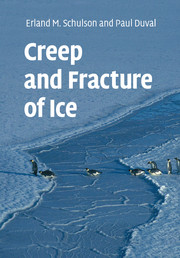Book contents
- Frontmatter
- Contents
- Preface
- Acknowledgements
- 1 Introduction
- 2 Structure of ice
- 3 Microstructure of natural ice features
- 4 Physical properties: elasticity, friction and diffusivity
- 5 Plastic deformation of the ice single crystal
- 6 Ductile behavior of polycrystalline ice: experimental data and physical processes
- 7 Modeling the ductile behavior of isotropic and anisotropic polycrystalline ice
- 8 Rheology of high-pressure and planetary ices
- 9 Fracture toughness of ice
- 10 Brittle failure of ice under tension
- 11 Brittle compressive failure of unconfined ice
- 12 Brittle compressive failure of confined ice
- 13 Ductile-to-brittle transition under compression
- 14 Indentation fracture and ice forces on structures
- 15 Fracture of the ice cover on the Arctic Ocean
- Index
- References
13 - Ductile-to-brittle transition under compression
Published online by Cambridge University Press: 01 February 2010
- Frontmatter
- Contents
- Preface
- Acknowledgements
- 1 Introduction
- 2 Structure of ice
- 3 Microstructure of natural ice features
- 4 Physical properties: elasticity, friction and diffusivity
- 5 Plastic deformation of the ice single crystal
- 6 Ductile behavior of polycrystalline ice: experimental data and physical processes
- 7 Modeling the ductile behavior of isotropic and anisotropic polycrystalline ice
- 8 Rheology of high-pressure and planetary ices
- 9 Fracture toughness of ice
- 10 Brittle failure of ice under tension
- 11 Brittle compressive failure of unconfined ice
- 12 Brittle compressive failure of confined ice
- 13 Ductile-to-brittle transition under compression
- 14 Indentation fracture and ice forces on structures
- 15 Fracture of the ice cover on the Arctic Ocean
- Index
- References
Summary
Introduction
Our objective in this chapter is to consider the ductile-to-brittle transition within polycrystalline ice loaded under compression. We describe a physical model that accounts quantitatively for the effects (described below) of strain rate, temperature, grain size, confinement, salinity and damage and which accounts as well for the transition within a number of rocks and minerals. We express the transition in terms of a critical strain rate, although it could just as well be expressed in terms of other factors. However, strain rate seems to be the most useful, because it spans the widest range of environmental and microstructural conditions encountered in practice.
The critical strain rate marks the point where compressive strength (Chapters 11 and 12) and indentation pressure (Chapter 14) reach a maximum. It is thus a point of considerable importance in relation to ice loads on offshore structures. It is of interest as well in relation to the rheological behavior of the sea ice cover on the Arctic Ocean (Chapter 15) and to the deformation of icy material of the outer Solar System.
Competition between creep and fracture
Three explanations have been offered. An early view, particularly in relation to the transition during indentation failure in the field (Sanderson, 1988), was that the transitional strain rate marks the conditions under which the first cracks nucleate, somewhat analogous to the transition under tension.
- Type
- Chapter
- Information
- Creep and Fracture of Ice , pp. 320 - 335Publisher: Cambridge University PressPrint publication year: 2009



